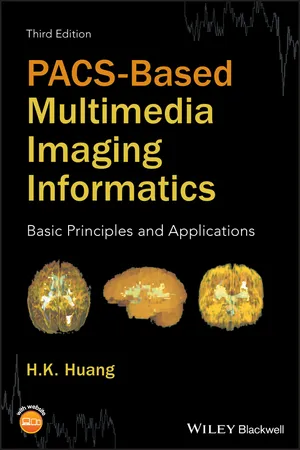
PACS-Based Multimedia Imaging Informatics
Basic Principles and Applications
H. K. Huang
- English
- ePUB (adapté aux mobiles)
- Disponible sur iOS et Android
PACS-Based Multimedia Imaging Informatics
Basic Principles and Applications
H. K. Huang
À propos de ce livre
Thoroughly revised to present the very latest in PACS-based multimedia in medical imaging informatics—from the electronic patient record to the full range of topics in digital medical imaging—this new edition by the founder of PACS and multimedia image informatics features even more clinically applicable material than ever before. It uses the framework of PACS-based image informatics, not physics or engineering principles, to explain PACS-based multimedia informatics and its application in clinical settings and labs. New topics include Data Grid and Cloud Computing, IHE XDS-I Workflow Profile (Integrating the Healthcare Enterprise Cross-enterprise Document Sharing for Imaging), extending XDS to share images, and diagnostic reports and related information across a group of enterprise health care sites.
PACS-Based Multimedia Imaging Informatics is presented in 4 sections. Part 1 covers the beginning and history of Medical Imaging, PACS, and Imaging Informatics. The other three sections cover Medical Imaging, Industrial Guidelines, Standards, and Compliance; Informatics, Data Grid, Workstation, Radiation Therapy, Simulators, Molecular Imaging, Archive Server, and Cloud Computing; and multimedia Imaging Informatics, Computer-Aided Diagnosis (CAD), Image-Guide Decision Support, Proton Therapy, Minimally Invasive Multimedia Image-Assisted Surgery, BIG DATA.
- New chapter on Molecular Imaging Informatics
- Expanded coverage of PACS and eHR's (Electronic Health Record), with HIPPA compliance
- New coverage of PACS-based CAD (Computer-Aided Diagnosis)
- Reorganized and expanded clinical chapters discuss one distinct clinical application each
- Minimally invasive image assisted surgery in translational medicine
- Authored by the world's first and still leading authority on PACS and medical imaging
PACS-Based Multimedia Imaging Informatics: Basic Principles and Applications, 3 rd Edition is the single most comprehensive and authoritative resource that thoroughly covers the critical issues of PACS-based hardware and software design and implementation in a systematic and easily comprehensible manner. It is a must-have book for all those involved in designing, implementing, and using PACS-based Multimedia Imaging Informatics.